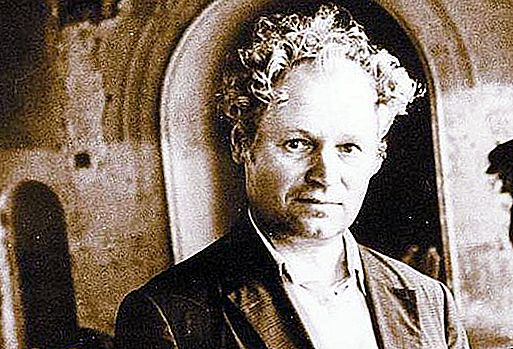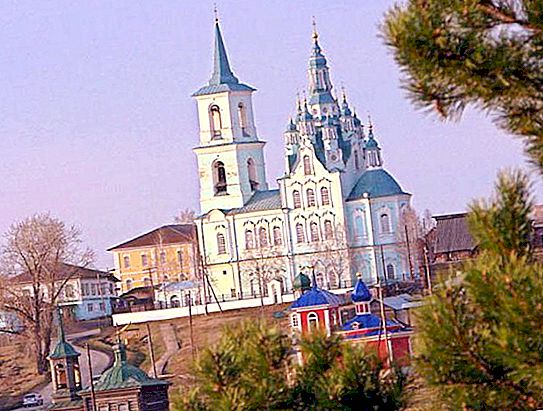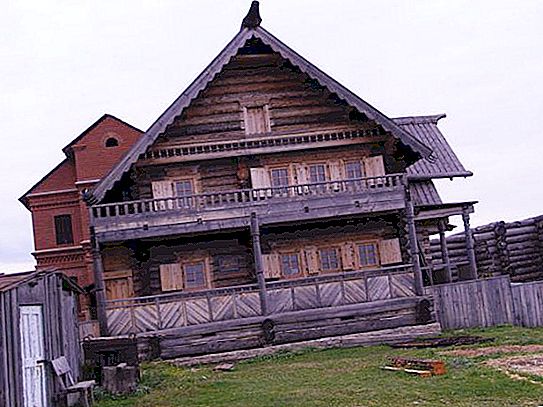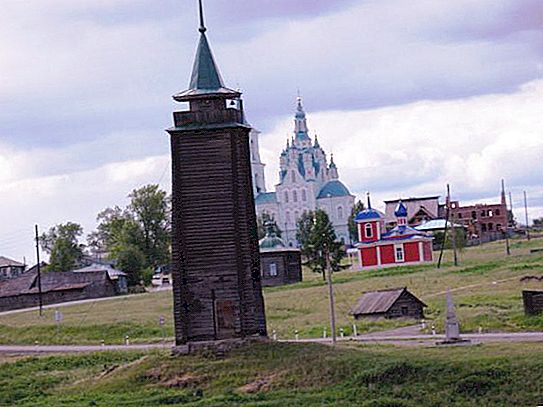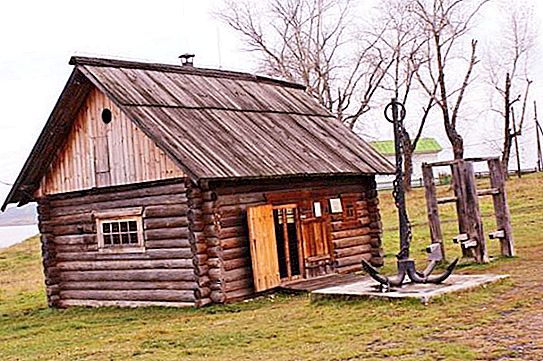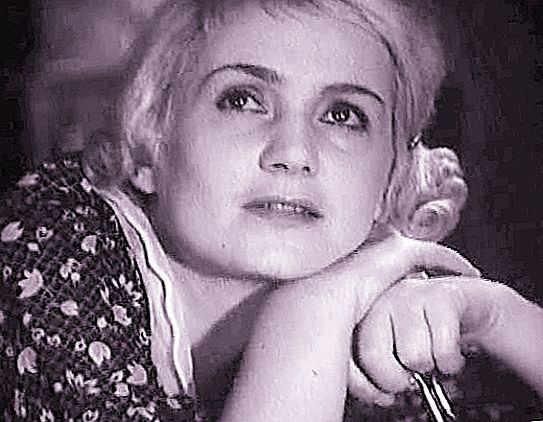Creating a new one is impossible without relying on the experience of past generations. Preserving the cultural heritage, its material and spiritual components, is the best way to preserve our own national identity. Museums, based on folklore, architecture and spirit, take pride of place, attract visitors with artlessness and the opportunity to understand themselves.
The village of Lower Sinyachikha
Alapaevsky district of the Sverdlovsk region could remain an ordinary place on the map of Russia, if not for the village of Lower Sinyachikha. For several decades, the Museum of Wooden Architecture has been operating here, the exhibits of which have no analogues in the world. The foundation of the village is considered to be 1680, for which there is a sign at the entrance to the village.
Residential and administrative buildings are located along the Irbitsky tract. Once there was an ironworks owned by the dynasty of industrialist Yakovlev. Today, a memorial sign has been erected on the site of the enterprise and the factory building has been preserved, which locals call the “White House” in the old manner. This is not the only architectural monument with which Nizhnyaya Sinyachikha became famous. The Museum-Reserve of Wooden Architecture and Folk Art named after I. D. Samoilov, which is located in the open air, attracts a stream of tourists to these parts.
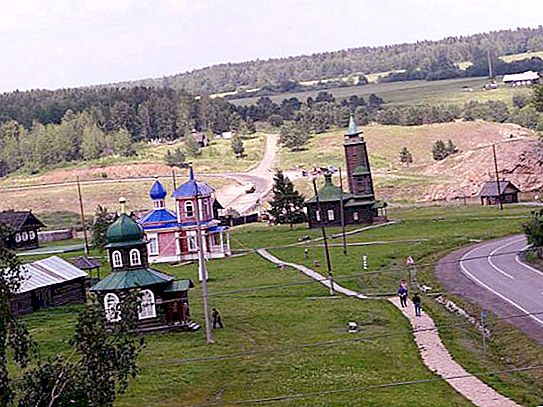
Museum founder
In 1978, a museum was officially organized in the village of Nizhnyaya Sinyachikha, but its founder Ivan Danilovich Samoilov began collecting his exposition and fighting to preserve the collection long before this date. Returning after the war to his native village of Isakova, I. D. Samoilov began to study the history of his and the surrounding villages of the Alapaevsky district. Working as a land surveyor, he traveled all over the Urals, where he constantly faced with an endangered history.
He became interested in local history, archeology, restoration. In his book “Treasures of the Lower Sinyachikha, ” he writes: “Then, in the post-war years, this beauty was still preserved. You go into some remote village, it happened, in a hut, and you gasp: it’s so outlandishly painted - your hand reaches for a hat at the entrance. Or you’ll see an old spinning wheel, a tuesok, which you’ll bring to any museum at least immediately. ”
He began to collect a collection that included old-printed books, household items, brush icons of local artists, painted parts of old buildings, samples of weaving and embroidery. The place, suitable for the museum exposition, turned out to be a dilapidated Transfiguration Church in the village of Lower Sinyachikha. The Museum-Preserve of Wooden Architecture was created for decades solely thanks to the enthusiasm of Ivan Danilovich.
Museum open to the sky
The restoration of the Transfiguration Church, built in the 18th century, began in 1970. The process was slow, it was necessary to rely only on our own resources, there was no support from the state, the work stretched for 10 years. During this period, Samoilov had the idea of preserving not only household items, but also entire wooden buildings that were mercilessly destroyed by people and time. In 1978, in the building of the temple, Ivan Danilovich opened a museum of folk art, the basis of the exhibition becomes his personal collection of house painting of the Urals.
The Museum-Reserve of Wooden Architecture and Folk Art located in the village of Nizhnyaya Sinyachikha consists of 25 wooden buildings dating back to different centuries and collected throughout the Urals. Here there are village huts, the architecture of which can be used to trace changes in peasant life, several churches and chapels, a magnificent example of Siberian baroque - the Transfiguration Cathedral, wells, the watch tower of the fire section, the sovereign customs house and many other monuments. Historically, wooden buildings span the period from the 17th to the 20th century.
It is especially interesting to consider the old buildings and compare them with the housing in which Sinyachikhins live now. The museum is an integral part of the village, all historical monuments are spread between the courtyards of the villagers. In 1995, the Museum in Lower Sinyachikha receives federal status of an object of historical and cultural heritage, in addition, it is currently under the protection of UNESCO.
Sovereign Customs House
The customs building once stood on the side of the Siberian Highway in the Tugulymsky district, in the village of Luchinkino (Sverdlovsk Region). It was noticed in 1986 by members of an expedition created from students and teachers of the Sverdlovsk Architectural Institute. After denrochronological analysis, it became clear that the building was the oldest building in the Urals and belonged to the beginning of the 19th century.
When the historical value of the house became known, it already belonged to a Tyumen businessman who wished to carry out repairs in it and adapt it to modern requirements. The house was rapidly collapsing, at the price of firewood Samoilov purchased decorative elements from the owner, carved hand-made balusters, window frames, decks and other parts of the structure.
They decided to recreate it according to the remaining architectural drawings, measurements, and imported details in the village of Nizhnyaya Sinyachikha. The Museum-Reserve of Wooden Architecture is justly proud of its unique structure. The house is a two-story six-log cabin. In the Russian tradition, such buildings were called mansions. Restoration and restoration work has not yet been completed in the interior, but the appearance of the building is already fully consistent with the original.
Farmsteads
To assemble old wooden houses of different eras is not an easy task, they were practically not preserved in integrity. Therefore, some peasant houses of the exhibition were collected from several log huts in different regions of the Urals and placed in the village of Lower Sinyachikha. The museum-reserve of wooden architecture in the arsenal has estates of the 17th, 18th and 19th centuries.
The oldest 17th-century manor is collected almost on a log. The basis was a house from the village of Tabory, the ceiling came from the village of Cheremisina, the pediment was preserved from the house of the village of Nikonovoye, some logs came from the village of Mysy. The composition of the estate includes an old barn. The internal interior recreates the life of peasants of the 17th century. A well with a “crane” was restored in the courtyard, wooden wells in the museum are presented in several historical reconstructions, there are existing ones. In the backyard lies a wooden hollowed-out deck from the village of Gryaznukha, intended for feeding livestock. The age of the tree deck is 234 years. There is also a bathhouse, cut down from only three half logs, which are several hundred years old, it was brought to the museum from the village of Gorodishche.
The 18th-century peasant's manor house consists of a residential hut delivered from the village of Vogulka and farm buildings. The old barn of the complex is from the village of Kuliga. The estate has an exposition of household items, tools of the peasants.
In the 19th century, the hut was decorated with carvings, paintings, and the interior was complicated. A sample of wooden house architecture fell into the museum-reserve from the village of Kamelskaya. The two-story old barn, which completes the ensemble of the Ural village house, arrived from the village of Kirovsky. The interior of the house is “White Room”, the painting of the walls of the room dates from 1897.
Wooden wells
In addition to the well with the "crane", in the central part of the reserve there is a recently operating well with a large wooden wheel. The rise of water was carried out by rotating the wheel, a chain or rope was nailed at one end to a wooden roller, a bucket was attached to the opposite end of the chain. The wheel spun, the chain wound on a roller, and in such a straightforward way a bucket full of water rose. The well itself is Nizhny Sinyachikhinsky, and the wheel was brought from the village of Savino. Another well in the museum is nicknamed Danilych in honor of the founder of the exposition.
Chapels
On the territory of the museum-reserve there are five wooden chapels:
- Spasskaya. The miniature building was brought from the village of Yurt; for a long time, it was disassembled in the Yekaterinburg Museum of Local Lore. Since 2001, the assembled chapel, an example of 19th-century architecture, is located in Lower Sinyachikha.
- Ascension. Dated to the beginning of the 19th century, was found in the village of Karpova. It is distinguished from the rest by the brightness of the facade: a white basement, a bright blue figured roof, and brown walls. There is an exhibition of local craftswoman Kh. D. Chuprakova in the room.
- Savvatiya and Zosima. Originally from the now defunct village of Koksharova. She appeared in the museum in 1981. There is an exposition dedicated to wood carving in the room. It also demonstrates the model of the Holy Cross Church, which once stood in the Kirtomsky monastery. She had a unique architecture: 11 chapters, rich carvings, covered galleries. The church was prepared for the move, but there was a fire and it was destroyed.
- Elijah the Prophet. Delivered to the territory of a rural cemetery. Today's building is a replica of the temple that once stood on the same spot.
- Alexander Nevsky. Before moving to the museum, she was in the village of Ostanino. She was placed on a rock above the pond. From afar, the octagonal chapel is more like an arbor. The windows are decorated with painted shutters, the entrance is with a carved porch. In 2015, during excavations, a rich ancient sanctuary was found under the chapel. Ceramics, Scythian bronze arrowheads, sewing needles, jewelry and much more were brought to light.
Towers and other buildings
Approaching the museum-reserve, in addition to the main architectural dominant of the Transfiguration Church, tourists pay attention to several high wooden towers. One of them is the watchtower of Aramashevsky prison - the reconstruction of a sentinel defensive structure from the village of Aramashevo. Such jails were built in the 17-18th centuries and have not survived to this day.
Next to the cautious tower is the fire department building with a bell tower and a viewing platform on the roof. There is a museum dedicated to firefighting in the interior, there are old exhibits: water barrels, tools, old-style fire engines. In the yard there is a huge wooden barrel for water. Previously, the building was located in the village of Katyshka.
The high watchtower near the fire department also served as fire protection in the working village of Krasnogvardeisky. Its height is 35 meters. They were going to take it for firewood in 1979. It was possible to save the building only by the efforts of Samoilov. Together with a partner in a few days, they took it apart by a log, which was very difficult due to the fasteners, noted Ivan Danilovich.
The building adjacent to the fire tower is an old blacksmith's shop, and a horse mill has been set up next to it, where they were tied to shoe it. Blacksmiths sometimes work in it, observing ancient forging technologies. Here you can see the details of the tools. In front of the entrance is a forged anchor found in the river Rezh.
In addition to the mentioned buildings, in the reserve there was a place for a windmill, plant management of the time of the merchants Yakovlev. The museum hosts ethnographic festivals, exhibitions of artists and craftsmen.


